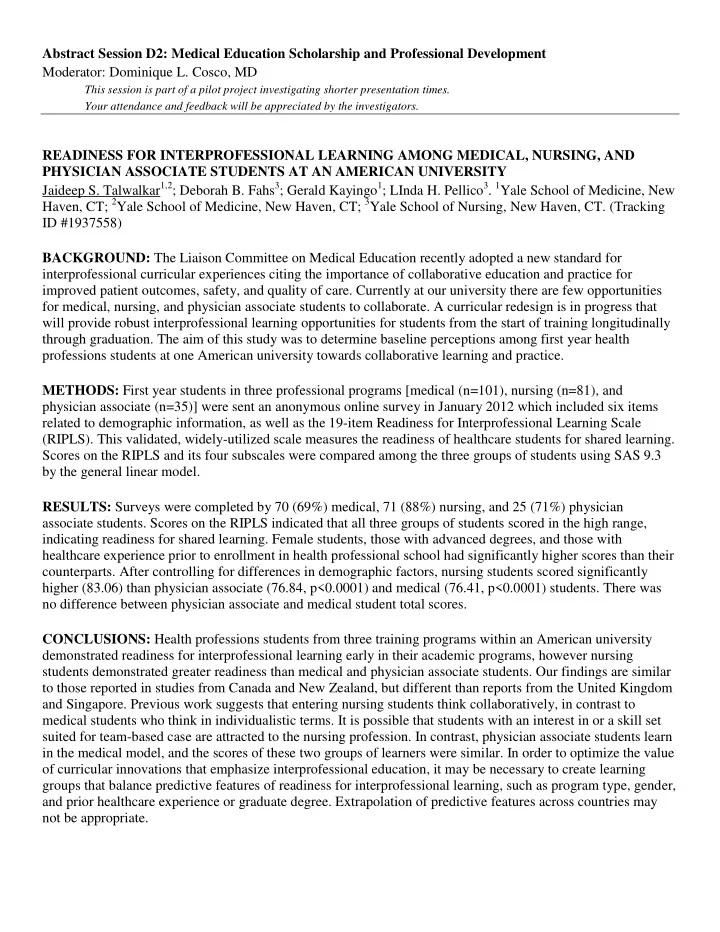

Abstract Session D2: Medical Education Scholarship and Professional Development Moderator: Dominique L. Cosco, MD This session is part of a pilot project investigating shorter presentation times. Your attendance and feedback will be appreciated by the investigators. READINESS FOR INTERPROFESSIONAL LEARNING AMONG MEDICAL, NURSING, AND PHYSICIAN ASSOCIATE STUDENTS AT AN AMERICAN UNIVERSITY Jaideep S. Talwalkar 1,2 ; Deborah B. Fahs 3 ; Gerald Kayingo 1 ; LInda H. Pellico 3 . 1 Yale School of Medicine, New Haven, CT; 2 Yale School of Medicine, New Haven, CT; 3 Yale School of Nursing, New Haven, CT. (Tracking ID #1937558) BACKGROUND: The Liaison Committee on Medical Education recently adopted a new standard for interprofessional curricular experiences citing the importance of collaborative education and practice for improved patient outcomes, safety, and quality of care. Currently at our university there are few opportunities for medical, nursing, and physician associate students to collaborate. A curricular redesign is in progress that will provide robust interprofessional learning opportunities for students from the start of training longitudinally through graduation. The aim of this study was to determine baseline perceptions among first year health professions students at one American university towards collaborative learning and practice. METHODS: First year students in three professional programs [medical (n=101), nursing (n=81), and physician associate (n=35)] were sent an anonymous online survey in January 2012 which included six items related to demographic information, as well as the 19-item Readiness for Interprofessional Learning Scale (RIPLS). This validated, widely-utilized scale measures the readiness of healthcare students for shared learning. Scores on the RIPLS and its four subscales were compared among the three groups of students using SAS 9.3 by the general linear model. RESULTS: Surveys were completed by 70 (69%) medical, 71 (88%) nursing, and 25 (71%) physician associate students. Scores on the RIPLS indicated that all three groups of students scored in the high range, indicating readiness for shared learning. Female students, those with advanced degrees, and those with healthcare experience prior to enrollment in health professional school had significantly higher scores than their counterparts. After controlling for differences in demographic factors, nursing students scored significantly higher (83.06) than physician associate (76.84, p<0.0001) and medical (76.41, p<0.0001) students. There was no difference between physician associate and medical student total scores. CONCLUSIONS: Health professions students from three training programs within an American university demonstrated readiness for interprofessional learning early in their academic programs, however nursing students demonstrated greater readiness than medical and physician associate students. Our findings are similar to those reported in studies from Canada and New Zealand, but different than reports from the United Kingdom and Singapore. Previous work suggests that entering nursing students think collaboratively, in contrast to medical students who think in individualistic terms. It is possible that students with an interest in or a skill set suited for team-based case are attracted to the nursing profession. In contrast, physician associate students learn in the medical model, and the scores of these two groups of learners were similar. In order to optimize the value of curricular innovations that emphasize interprofessional education, it may be necessary to create learning groups that balance predictive features of readiness for interprofessional learning, such as program type, gender, and prior healthcare experience or graduate degree. Extrapolation of predictive features across countries may not be appropriate.
THE IMPACT OF JOB BURNOUT ON MEDICATION PRESCRIPTION ERRORS IN FIRST-YEAR INTERNAL MEDICINE RESIDENTS Jennifer P. Weintraub; Robert Fallar; Jason Kwah; Jonathan Ripp. Mount Sinai School of Medicine, New York, NY. (Tracking ID #1937580) BACKGROUND: Job Burnout has been increasingly recognized as common among internal medicine (IM) residents. Several studies have found that residents with burnout are more likely to self-report suboptimal patient care than those who are burnout free. Few studies have objectively measured the correlation between resident burnout and medical errors. We hypothesize that residents with burnout are more likely to commit medication prescription errors than their burnout-free counterparts. METHODS: We administered a survey containing the Maslach Burnout Inventory to first-year IM residents at the Icahn School of Medicine at Mount Sinai twice between June 2011 and June 2012. Burnout was defined by a high score on either the depersonalization or emotional exhaustion domain, in keeping with the most widely used convention. Subsequently, data on all medication orders placed by these residents during the same 1 year period were collected. Based on pharmacy annotations, prescriber orders with the potential to cause adverse drug events (e.g. drug interactions, incorrect dosing) were identified and measured as a rate of errors per 100 prescriptions. Individual burnout scores and prescription error rates were linked using anonymous identifiers and analyzed for correlations using SAS statistical software. RESULTS: Of the 54 eligible first-year residents, 53 (98%) completed an initial survey and 32 (59%) completed a follow-up survey. Burnout prevalence was 36% (19/53) at the beginning of intern year and 75% (24/32) at year's end. Burnt-out residents had a significantly lower rate of pharmacy interventions compared with their burnout-free counterparts in both the initial survey (0.558/100 vs. 0.752/100; p=0.005) and the year- end survey. (0.553/100 vs. 0.780/100; p=0.007) CONCLUSIONS: Burnt-out residents committed fewer prescription errors when compared with their burnout- free colleagues. This finding was contrary to our initial hypothesis and inconsistent with previously published findings based on self-report. Given the low error rate and the uncertain clinical significance of a correlation between burnout and decreased prescriber errors, further research is necessary to evaluate the link between job burnout and patient care in IM residents.
Recommend
More recommend